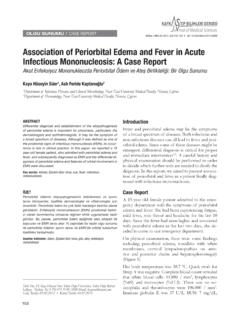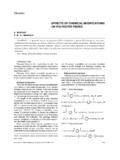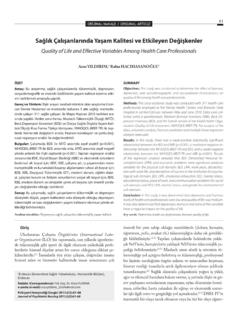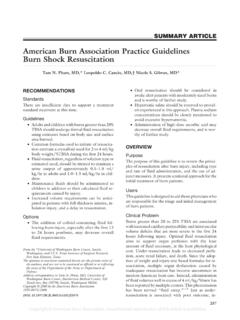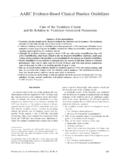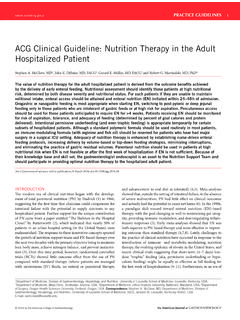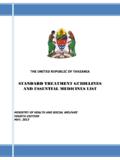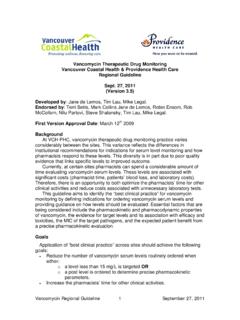Transcription of Guideline and treatment algorithm for burn injuries
1 Guideline and treatment algorithm for burn injuriesAhmet nar Yast , ,1,2 Emrah enel, ,3 Mutlu Saydam, ,4 Geylani zok, ,5 Atilla oruh, ,6 Kaya Yorganc , of General Surgery, Hitit University Faculty of Medicine, orum;2 Ankara Numune Training and Research Hospital, burn treatment Center, Ankara;3 Department of Pediatric Surgery, Y ld r m Beyaz t University Faculty of Medicine, Ankara;4 Department of Esthetic, Plastic and Reconstructive Surgery and Burns Unit, Yunus Emre Governmental Hospital, Eski ehir;5 Department of Pediatric Surgery, Ege University Faculty of Medicine, zmir;6 Department of Esthetic, Plastic and Reconstructive Surgery, Erciyes University Faculty of Medicine, Kayseri;7 Department of General Surgery, Hacettepe University Faculty of Medicine, AnkaraABSTRACTAs in many other countries, burn injuries are a challenging healthcare problem in Turkey.
2 Initial management of burn patients is very important for future morbidity and mortality. Therefore, the Turkish Ministry of Health prepared National Burns treatment Algo-rithm aided by the Scientific Burns Council. The basic aim of this algorithm is to guide physicians in the treatment of burn victims until they reach an experienced burns center. The content of this algorithm is first aid, initial management, resuscitation, and transfer policy. The Council started to work on this algorithm in 2011. Various consultants, including general surgeons, pediatric surgeons, aesthetic, plastic and reconstructive surgeons, anesthesiologists, and intensive care physicians, revised the first draft and it was sent to eight education and research hospitals of the Ministry of Health, four universities, and seven non-governmental organizations.
3 In the last quarter of 2012, the algorithm was finalized and approved by the Scientific Council, after which, it was approved by the Ministry of Health and words: algorithm ; burn ; Guideline ; Depth of the burn : Burns are classified as superficial and deep dermal in clinical practice. In superficial burns, there is no or minimal dermal injury. These are first degree and superficial second degree burns, and usually heal in 3 weeks without any dermis is partially or completely injured in deep dermal burns. They are classified as deep second, third and fourth degree regarding dermal injury and underlying deep tissues. These will usually heal in more than three weeks and usually require surgical Degree: Epidermis is intact, there is erythema, : sunburnSecond Degree: Epidermal integrity is damaged.
4 If the injury is limited to the upper layers of dermis, it is superficial second degree; however, involve-ment of the deeper (reticular) layers leads to deep second degree burn . While superficial is much more painful, there is less pain and a blunt pressure feeling in deep Degree: All layers of the dermis are involved. The skin is hard, dark, dry, painless, thromboses REVIEWUlus Travma Acil Cerrahi Derg, March 2015, Vol. 21, No. 279 Address for correspondence: Ahmet nar Yast , Hani, ank r Cad., No: 67/2, D kap 06030 Ankara, TurkeyTel: +90 312 - 324 57 97 E-mail: Response CodeUlus Travma Acil Cerrahi Derg2015;21(2):79-89doi: 2015 TJTESD etermining burn Severity and On-Site Medical AttentionDetermining burn SeverityDetermining burn severity depends on the burned surface area, depth of burn and the involved body Burned Surface Area: The rule of nines can roughly estimate adult burns (Fig.)
5 1a). However, more accurate dia-grams are available for adults (Fig. 1b) and children (see Lund Browder s diagram), and a brief form of the diagram is shown in Fig. 2. For practical calculation, the outstretched palm with fingers together can be accepted as 1% of the body surface area for an individual (Fig. 3).Yast et al. Guideline and treatment algorithm for burn Injuriesinside the vessels, and there is typical burn Degree: All layers of the skin, subcutaneous fat tissue and deeper tissues (muscles, tendons) are involved, and there is a carbonized Burned Body Site: Burns of the eye, ear, face, hands, feet, and genitalia are special area burns and should be treat-ed at an experienced burns burn Severity1.
6 Minor Burnsa. Second degree adult burns less than 15% TBSAb. Second degree child burns less than 10% TBSAc. Third degree child or adult burns less than 2% TBSA2. Moderate Burnsa. Second degree adult burns involving 15 to 25% TBSAb. Second degree child burns involving 10 to 20% TBSAc. Third degree child or adult burns involving 2 to 10% TBSA3. Major Burna. In adults, second degree burns greater than 25% TBSA b. In children, second degree burns greater than 20% TBSAc. Third degree burns greater than 10% in an adult or a childd. Inhalation injurye. Electrical burnsf. Burns with concomitant additional trauma (such as head trauma, intra-abdominal injury, fractures)g. Burns during pregnancyh.
7 Co-morbidities adding significant risk to burns (such as Diabetes Mellitus, corticosteroid use, immune suppres-sion)i. Burns of the eye, ear, face, hand, foot, major joint and burns can be treated as an outpatient or in a burns room. Moderate and severe burns must be hospitalized and treated in a burns Medical Attention1. Airway, breathing and circulation should be assessed. In a multiple trauma patient, the forget the burn principle is valid and the management of life threatening injury has Rescuing the victim from the burning premises and extin-guishing the fire have In minor burns, the burned area should be kept under running tap water for 20 minutes within the first 15 min-utes, and further burning should be Hot liquid burns Ulus Travma Acil Cerrahi Derg, March 2015, Vol.
8 21, No. 1. (a) The rule of nines diagram. (b) Schema for estimation of body surface area in (a)(b)Figure 1. (a) The rule of nines diagram. (b) Schema for estimation of body surface area in et al. Guideline and treatment algorithm for burn Injuriesbe rinsed with running water until the pain is relieved (this could take 60 minutes) Neutralizing agents are not recommended (contra- in-dication as may cause further heat)A large intravenous line insertion is required for every major burn case and Ringer s lactate solution should be the choice of fluid resuscitation. Circulation, respiration, and urinary out-put are observed if necessary. Detailed information regarding the event and the patient s medical history should be obtained, and the emergency physician or burns sur-geon where the patient is to be trans-ferred should be informed of the burn severity and relevant medical history.
9 Due to the expected edema forma-tion in large burns, jewelry, including bracelets, rings and necklaces should be wounds should not be covered with medicaments or substances on- All wet clothes are removed5. Flame burns The patient is removed from the heat source and moved from the scene to open-air; however, if not pos-sible, the fire is extinguished. Carbon monoxide or smoke intoxication is checked and the patient is administered 100% oxygen. Requirement for endotracheal intubation is Electrical Burns Health care provider should be aware that the patient is likely to be injured in three different ways: real elec-trical injury via electric current, arc burns, and flame burns as a consequence of the electric current ignition.
10 The electricity is turned off and/or the patient should be removed from the source, Requirement for immediate cardiopulmonary resuscita-tion is evaluated (especially in low voltage injuries ) Sign or symptoms of multiple trauma, blunt or pene-trating trauma must be checked,7. Chemical Burns Dry chemicals are firstly brushed off, and then, should Ulus Travma Acil Cerrahi Derg, March 2015, Vol. 21, No. 281 Figure 2. Lund-Browder 0 1 5 10 15 AdultFront or back half (%) (%) (%) (%) (%) (%)I (Head) 9 8 6 5 4 3 II (Thigh) 2 3 4 4 4 4 III (Leg) 2 2 2 3 3 3 1%1%1%1%2%2%2% 3. Practical es-timation using Travma Acil Cerrahi Derg, March 2015, Vol. 21, No. 282 Yast et al. Guideline and treatment algorithm for burn InjuriesTable 1.


